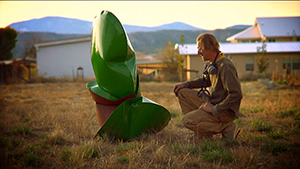Thomas, Jeremy

Admirers of Jeremy Thomas’ sculpture should be grateful to a thief. Thomas came to the College of Santa Fe to study Studio Arts as a painter and printmaker, both of which he had been doing since high school, even apprenticing with a master printmaker in his native Oklahoma. However, one semester while moving out of his dormitory, with boxes and bags piled around, the wooden box which held all of his brushes and painting supplies went missing. One moment it was on the curb, the next it was gone. Thus ended Thomas’ career as a painter. The next semester he took a sculpting class and never turned back.
While Thomas is happy to converse about theory and concept, he is most content thinking of himself as a maker of objects rather than an “artist”. To him, the label of “artist” is a mantle placed onto a person by society, which in the current day has as much to do with trends as it does with the production of great work. He is insistent that making objects is a natural impulse for all humans. Some people make pies or spread-sheets, some make books or sculptures.
It is the pragmatic that draws Thomas. Asked about his influences he asserts that his primary influences do not come from the realm of art but rather from everyday living. “I don’t eat, sleep, and breathe art,” he comments. His discovery of metal-working arose in a similar, practical way. Thomas had been sculpting with stone and asked someone to show him how to forge his own chisel. This was the start of his exploration of forging techniques and after a time he gave up working with stone to work with metal. One of the key aspects of blacksmithing that intrigued Thomas was fact that it isn’t instantly gratifying, and it poses questions that aren’t easily solved. He interned with Tom Joyce (recipient of a MacArthur genius grant) and later worked in Santa Fe as a blacksmith creating items as diverse as fireplace screens and light fixtures, but always continuing to make the objects of “art”.
His current inflatable steel sculpting technique is something he stumbled upon during a demo for one of his sculpture classes. Steel, Thomas says, has a clay-like malleability at high temperatures. He welds forms together which can be heated and injected with pressurized air, causing them to inflate and “grow” into their final shape. The final pieces contain paradoxes: metal molded by air, sensual forms in forceful fetish-finish primary colors gleaned from tractor manufacturers. These sculptures are changeable (as one continuously finds new approaches in their creases, angles, and wrinkles); they allow a dialogue between viewer and work. Thomas says he engages in an ongoing dialogue, a give and take, with his materials. He says, “Art is the science of play”, a creed that Thomas takes to heart, both in his work and in his life.
Episode:
Jeremy Thomas, Eureka Forge Studio, Harley-Davidson, Andrea Li
